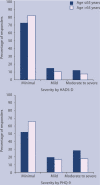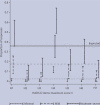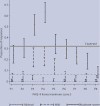Identification of depression in diabetes: the efficacy of PHQ-9 and HADS-D
- PMID: 20529487
- PMCID: PMC2880765
- DOI: 10.3399/bjgp10X502128
Identification of depression in diabetes: the efficacy of PHQ-9 and HADS-D
Abstract
Background: Clinical guidelines advise screening for depression in patients with diabetes. The Patient Health Questionnaire (PHQ-9) and the depression subscale of the Hospital Anxiety and Depression Scale (HADS-D) are commonly used in primary care.
Aim: To compare the efficacy of HADS-D and PHQ-9 in identifying moderate to severe depression among primary care patients with type 2 diabetes.
Design of study: Self-report postal survey, clinical records assessed by GPs.
Setting: Seven metropolitan and rural general practices in Victoria, Australia.
Method: Postal questionnaires were sent to all patients with diabetes on the registers of seven practices in Victoria. A total of 561 completed postal questionnaires were returned, giving a response rate 47%. Surveys included demographic information, and history of diabetes and depression. Participants completed both the PHQ-9 and HADS-D. Clinical data from patient records included glycosylated hemoglobin (HbA1c) levels and medications.
Results: The proportion of the total sample completing HADS-D was 96.8% compared with 82.4% for PHQ-9. Level of education was unrelated to responses on the HADS-D but was related to completion of the PHQ-9. Using complete data (n = 456) from both measures, 40 responders showed HADS-D scores in the moderate to severe range, compared with 103 cases identified by PHQ-9. Only 35 cases were classified in the moderate to severe category by both the PHQ-9 and HADS-D. Items with the highest proportions of positive responses on the PHQ-9 were related to tiredness and sleeping problems and, on the HADS-D, feeling slowed down.
Conclusion: It may be that the items contributing to the higher prevalence of moderate to severe depression using the PHQ-9 are due to diabetes-related symptoms or sleep disorders.
Figures



Similar articles
-
Comparison of two self-rating scales to detect depression: HADS and PHQ-9.Br J Gen Pract. 2009 Sep;59(566):e283-8. doi: 10.3399/bjgp09X454070. Br J Gen Pract. 2009. PMID: 19761655 Free PMC article.
-
Psychometric comparison of PHQ-9 and HADS for measuring depression severity in primary care.Br J Gen Pract. 2008 Jan;58(546):32-6. doi: 10.3399/bjgp08X263794. Br J Gen Pract. 2008. PMID: 18186994 Free PMC article.
-
Differential item functioning of the HADS and PHQ-9: an investigation of age, gender and educational background in a clinical UK primary care sample.J Affect Disord. 2013 May;147(1-3):262-8. doi: 10.1016/j.jad.2012.11.015. Epub 2012 Dec 4. J Affect Disord. 2013. PMID: 23218250
-
The validity of the Hospital Anxiety and Depression Scale. An updated literature review.J Psychosom Res. 2002 Feb;52(2):69-77. doi: 10.1016/s0022-3999(01)00296-3. J Psychosom Res. 2002. PMID: 11832252 Review.
-
Case identification of depression in patients with chronic physical health problems: a diagnostic accuracy meta-analysis of 113 studies.Br J Gen Pract. 2011 Dec;61(593):e808-20. doi: 10.3399/bjgp11X613151. Br J Gen Pract. 2011. PMID: 22137418 Free PMC article. Review.
Cited by
-
Development of a brief psychological intervention for perinatal depression (BIND-P).Asia Pac Psychiatry. 2021 Mar;13(1):e12436. doi: 10.1111/appy.12436. Epub 2020 Oct 24. Asia Pac Psychiatry. 2021. PMID: 33098740 Free PMC article. Review.
-
PHQ-9: sensitivity to change over time.Br J Gen Pract. 2010 Jul;60(576):535-6. doi: 10.3399/bjgp10X514909. Br J Gen Pract. 2010. PMID: 20594450 Free PMC article. No abstract available.
-
A Consideration of the Psychological Aspects to Managing Patients with Painful Diabetic Neuropathy: An Insight into Pain Management Services at a Tertiary Centre in the UK.Diabetes Ther. 2021 Feb;12(2):487-498. doi: 10.1007/s13300-020-00983-y. Epub 2020 Dec 26. Diabetes Ther. 2021. PMID: 33367982 Free PMC article. Review.
-
Impact of sociodemographic and diabetes-related factors on the presence and severity of depression in immigrant chinese Australian people with diabetes.Clin Diabetes. 2014 Oct;32(4):163-9. doi: 10.2337/diaclin.32.4.163. Clin Diabetes. 2014. PMID: 25646942 Free PMC article.
-
Screening for major depressive disorder in adults with cerebral glioma: an initial validation of 3 self-report instruments.Neuro Oncol. 2013 Jan;15(1):122-9. doi: 10.1093/neuonc/nos282. Epub 2012 Dec 9. Neuro Oncol. 2013. PMID: 23229997 Free PMC article.
References
-
- Anderson RJ, Freedland KE, Clous RE, Lustman PJ. The prevalence of comorbid depression in adults with diabetes: a meta-analysis. Diabetes Care. 2001;24:1069–1078. - PubMed
-
- Ali S, Stone MA, Peters JL, et al. The prevalence of co-morbid depression in adults with type 2 diabetes: a systematic review and meta-analysis. Diabet Med. 2006;23:1165–1173. - PubMed
-
- Egede LE, Zheng D, Simpson K. Comorbid depression is associated with increased health care use and expenditures in individuals with diabetes. Diabetes Care. 2002;25:464–470. - PubMed
-
- NHS Employers, the General Practitioners' Committee. Quality and outcomes framework guidance for GMS contract 2009/10: delivering investment in general practice. 2009. March http://www.bma.org.uk/images/qof0309_tcm41-184025.pdf (accessed 6 May 2010)
Publication types
MeSH terms
LinkOut - more resources
Full Text Sources
Medical
Research Materials
